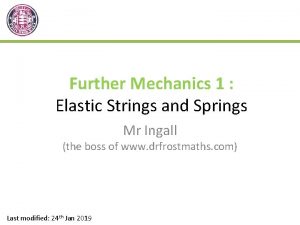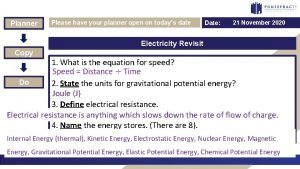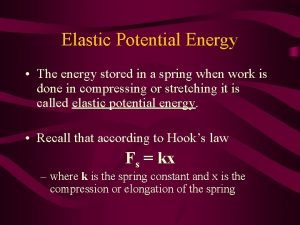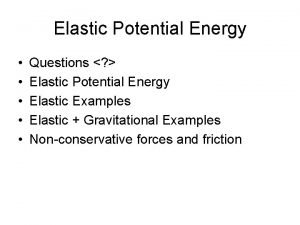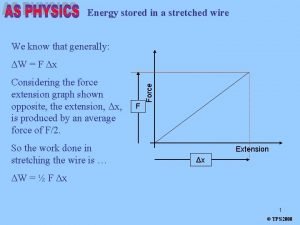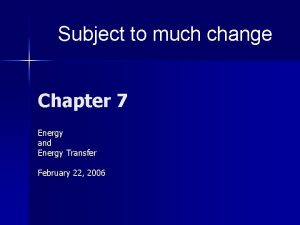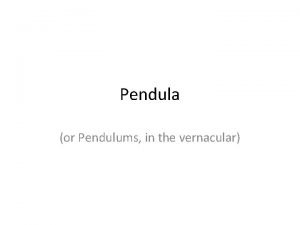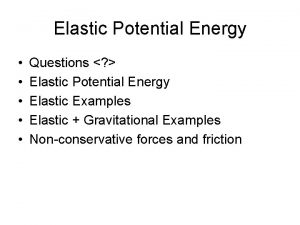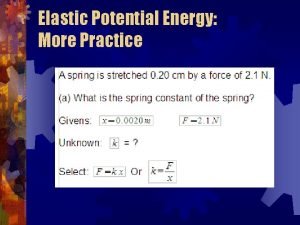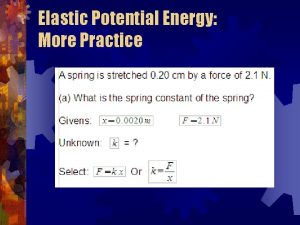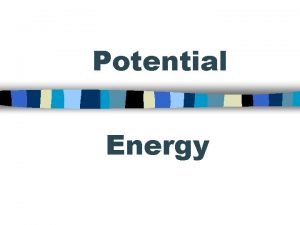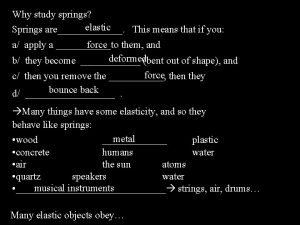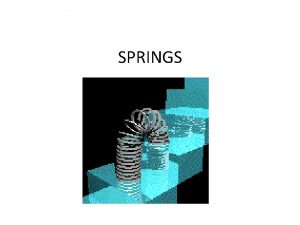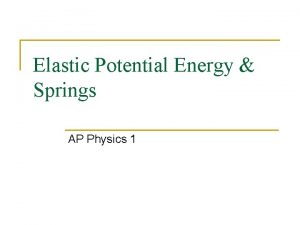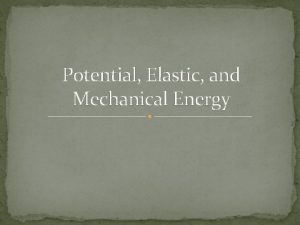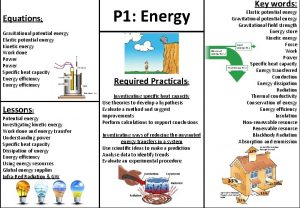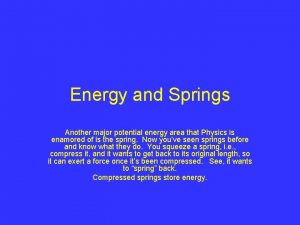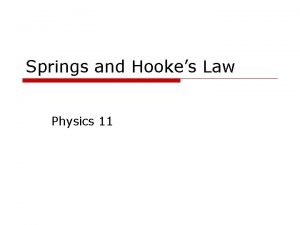Springs And pendula and energy Elastic Potential Energy
























- Slides: 24

Springs And pendula, and energy

Elastic Potential Energy n What is it? n n Energy that is stored in elastic materials as a result of their stretching. Where is it found? n n n n Rubber bands Bungee cords Trampolines Springs Bow and Arrow Guitar string Tennis Racquet

Hooke’s Law n n n A spring can be stretched or compressed with a force. The force by which a spring is compressed or stretched is proportional to the magnitude of the displacement (F a x). Hooke’s Law: Felastic = -kx Where: k = spring constant = stiffness of spring (N/m) x = displacement

Hooke’s Law Felastic = -kx k = spring constant = 10 (N/m) x = displacement = 0. 2 m F = - (0. 2 m)(10 N/m) = -2 N Why negative? Because the direction of the Force and the displacement are in opposite directions.

Hooke’s Law – Energy n n n When a spring is stretched or compressed, energy is stored. The energy is related to the distance through which the force acts. In a spring, the energy is stored in the bonds between the atoms of the metal.

Hooke’s Law – Energy n F = kx W = Fd W = (average F)d = d(average F) W = d*[F(final) – F(initial)]/2 W = x[kx - 0 ]/2 n W = ½ kx 2 = D PE + D KE n n

Hooke’s Law – Energy n This stored energy is called Potential Energy and can be calculated by PEelastic = ½ kx 2 Where: k = spring constant = stiffness of spring (N/m) x = displacement n The other form of energy of immediate interest is gravitational potential energy n n PEg = mgh And, for completeness, we have n Kinetic Energy KE = 1/2 mv 2

Simple Harmonic Motion & Springs n Simple Harmonic Motion: n n An oscillation around an equilibrium position in which a restoring force is proportional the displacement. For a spring, the restoring force F = -kx. n n The spring is at equilibrium when it is at its relaxed length. Otherwise, when in tension or compression, a restoring force will exist.

Restoring Forces and Simple Harmonic Motion n A motion in which the system repeats itself driven by a restoring force n n n Springs Gravity Pressure

Harmonic Motion n Pendula and springs are examples of things that go through simple harmonic motion. n Simple harmonic motion always contains a “restoring” force that is directed towards the center.

Simple Harmonic Motion & Springs n At maximum displacement (+ x): n n The Elastic Potential Energy will be at a maximum The force will be at a maximum. The acceleration will be at a maximum. At equilibrium (x = 0): n n n The Elastic Potential Energy will be zero Velocity will be at a maximum. Kinetic Energy will be at a maximum

Simple Harmonic Motion & Springs 1. 5 1 0. 5 Position 0 Velocity 0 -0. 5 -1 -1. 5 5 10 15 20 25 Acceleration

The Pendulum n Like a spring, pendula go through simple harmonic motion as follows. T = 2π√l/g Where: n T = period n l = length of pendulum string n g = acceleration of gravity n Note: 1. 2. This formula is true for only small angles of θ. The period of a pendulum is independent of its mass.

10. 3 Energy and Simple Harmonic Motion Example 3 Changing the Mass of a Simple Harmonic Oscilator A 0. 20 -kg ball is attached to a vertical spring. The spring constant is 28 N/m. When released from rest, how far does the ball fall before being brought to a momentary stop by the spring? What about a 0. 4 kg ball?

Simple Harmonic Motion & Pendula n At maximum displacement (+ y): n n n The Gravitational Potential Energy will be at a maximum. The acceleration will be at a maximum. At equilibrium (y = 0): n n n The Gravitational Potential Energy will be zero Velocity will be at a maximum. Kinetic Energy will be at a maximum

Conservation of Energy & The Pendulum n (mechanical) Potential Energy is stored force acting through a distance n n If I lift an object, I increase its energy Gravitational potential energy n n We say “potential” because I don’t have to drop the rock off the cliff Peg = Fg * h = mgh

Conservation of Energy n Consider a system where a ball attached to a spring is let go. How does the KE and PE change as it moves? n n Let the ball have a 2 Kg mass Let the spring constant be 5 N/m

Conservation of Energy n n What is the equilibrium position of the ball? How far will it fall before being pulled Back up by the spring?

Conservation of Energy & The Pendulum n n (mechanical) Potential Energy is stored force acting through a distance Work is force acting through a distance n n If work is done, there is a change in potential or kinetic energy We perform work when we lift an object, or compress a spring, or accelerate a mass

Conservation of Energy & The Pendulum Does this make sense? Would you expect energy to be made up of these elements? n n Peg = Fg * h = mgh What are the units?

Conservation of Energy & The Pendulum Units n Newton = ?

Conservation of Energy & The Pendulum Units n n Newton = kg-m/sec^2 Energy n n Newton-m Kg-m^2/sec^2

Conservation of Energy is conserved n PE + KE = constant For springs, n PE = ½ kx 2 For objects in motion, n KE = ½ mv 2

Conservation of Energy & The Pendulum n http: //zonalandeducation. com/mstm/physics/ mechanics/energy/spring. Potential. Energy/spri ng. Potential. Energy. html
 Springs and strings
Springs and strings Elastic potential energy worksheet with answers
Elastic potential energy worksheet with answers Kinetic energy example
Kinetic energy example Elastic potential energy
Elastic potential energy What is elastic potential energy
What is elastic potential energy What is elastic potential energy
What is elastic potential energy Types of collisions
Types of collisions A student places her 500g physics book
A student places her 500g physics book Energy stored in a stretched wire formula
Energy stored in a stretched wire formula Maximum elastic potential energy
Maximum elastic potential energy Elastic potential energy formula
Elastic potential energy formula Elastic potential energy formula
Elastic potential energy formula Elastic energy formula
Elastic energy formula Elastic fibers
Elastic fibers Electric potential energy
Electric potential energy Pe q
Pe q Smrek opadavý previsnutý
Smrek opadavý previsnutý Warren cup images
Warren cup images Mamma areolata
Mamma areolata Pendula or pendulums
Pendula or pendulums Potential energy of capacitor
Potential energy of capacitor Define kinetic energy
Define kinetic energy Kinetic energy of a spring
Kinetic energy of a spring Gravitational potential energy
Gravitational potential energy Kinetic energy and potential energy formula
Kinetic energy and potential energy formula
